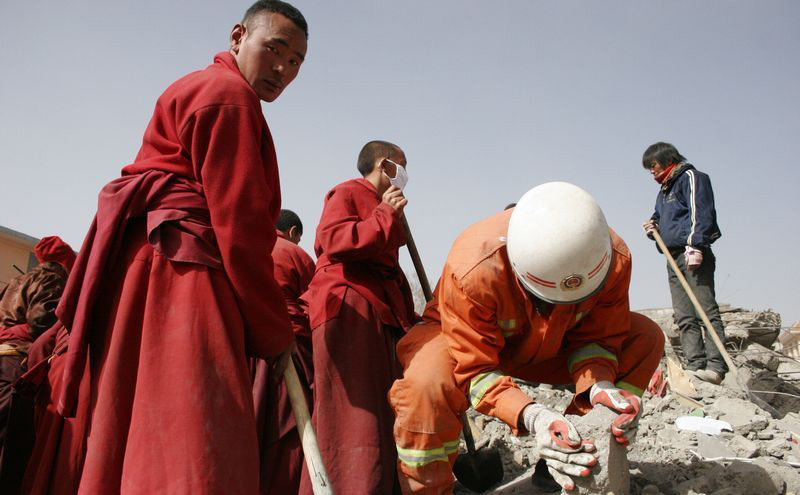China religion report released

Monks are assisting in rescue work in 2010 Yushu earthquake. Religious followers actively participate in volunteer activities in China.
A report on places of worship and the reconstruction of China’s religions, state-religion relations and demographics of religious followers was released in Beijing on July 7.
Published by Renmin University of China, the China Religion Survey Report (2015) presented findings from the China Religion Survey conducted by the School of Philosophy and National Survey Research Center at Renmin University of China. Twenty-eight universities and colleges nationwide and researchers from the Chinese Academy of Social Sciences also participated in the survey.
The survey aims to provide referential, multi-level basic data for the country’s academic studies and policy-making related to religion.
The first-phase survey, led by deputydean of the School of Philosophy at Renmin University of China Wei Dedong, was conducted from the second half of 2013 to the first half of 2015. It investigated 4,383 places of worship in 243 cities and counties using questionnaires.
The report found that 90 percent of religious places were restored after 1982 following approval from authorities. In terms of relations between state and religions, the report found religions have adapted to the socialist society.
The report found 90 percent of religious places have set up modern administrative institutions; more than 30 percent have staff participate in the administration and discussion of state affairs; 60 percent of religious leaders hold that official policies for religion are rational; and more than 40 percent of religious places are actively engaged in charity and activities for public good, according to the report.
The survey found that religions in China are willing to be guided by the authorities and maintain a harmonious relationship with the government. Generally, leaders of religious places hold a positive attitude toward the government’s funding for constructing religious places, incorporating religion into education and other policies.
The survey also found changes in the demographics of religious followers. Now, more than half of believers are under the age of 60, while in the past the elderly represented the biggest proportion of believers. Nevertheless, education is still low overall among believers, with 43 percent only having a primary or lower level of education, and no more than 5 percent receiving university education or above.
But the clergy structure has undergone positive change. The average age of 4,382 religious leaders is 55, with 21 percent being female and 15 percent having received a high level of education. The report found the “temporary clergy shortage in the 1960s has ended, with new generations coming out.”
As for the five major religions in China, the survey found each has distinctive advantages: Christianity adapts best to the current social environment. Buddhism contributes most to public good and charity, and has the greatest influence as a traditional religion. The most indigenous religion in China, Taoism, has the strongest influence internationaly with 11 percent of Taoist temples engaging in international exchanges. Some 43 percent of Catholics in China have received a university education, far exceeding the overall average among all religions of 18 percent, and 95 percent of mosques have rules and regulations, with Islam having the “most complete” system among all the five religions.
Looking to the future, the report noted the major direction of religious development is in social services by making contributions to morality, psychology and humanity education. The biggest expectation of religious circles in China is to increase places of worship and members to meet followers’ needs.

 PRINT
PRINT CLOSE
CLOSE